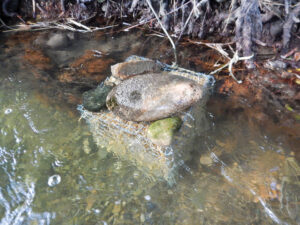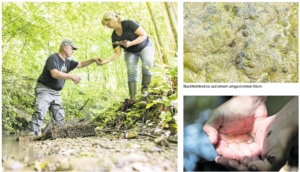In the current issue of FliegenFischen I was able to conduct an interview with Dr. Axel Wessolowski.
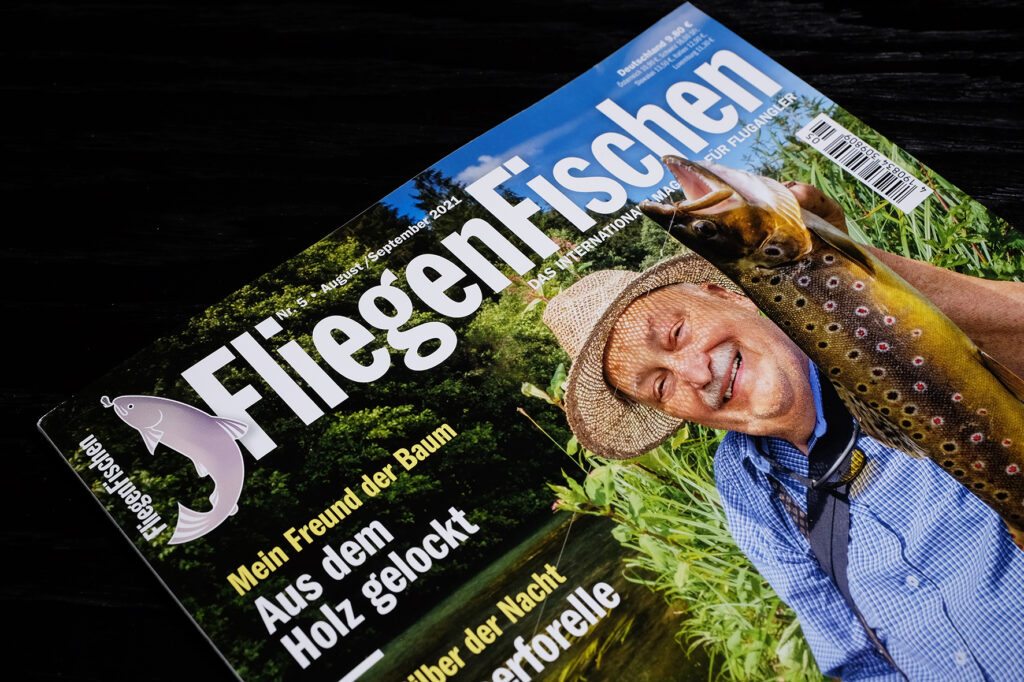
A living room for small animals
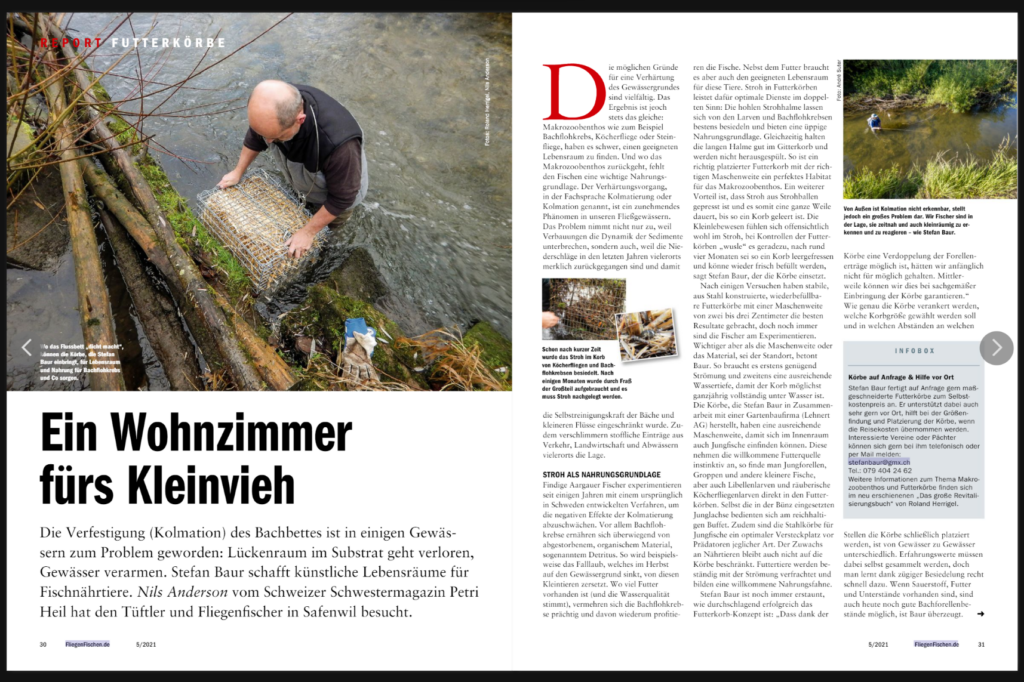
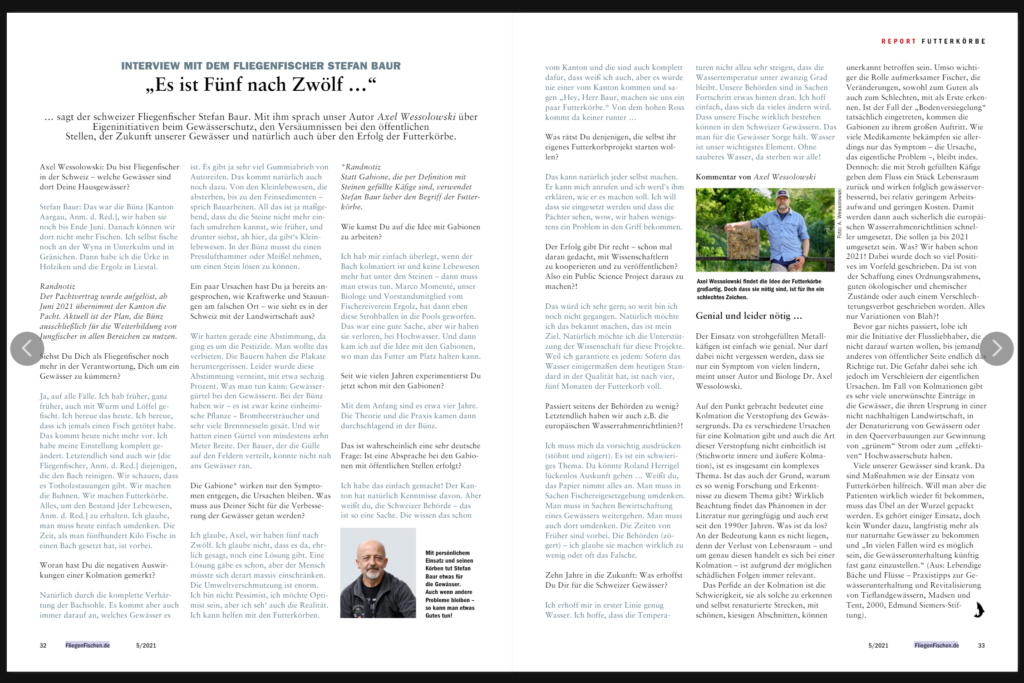
Transcript
A living room for small animals
The consolidation (clogging) of the stream bed has become a problem in some bodies of water: gaps in the substrate are lost, water bodies become impoverished. Stefan Baur creates artificial habitats for fish food. Nils Anderson from the Swiss sister magazine Petri Heil visited the inventor and fly fisherman in Safenwil.
There are many possible reasons for the hardening of the bottom of a watercourse. However, the result is always the same: macrozoobenthos such as freshwater shrimp, caddis flies or stoneflies have a hard time finding a suitable habitat. And where the macrozoobenthos decline, the fish lack an important source of food. The hardening process, known in technical terms as colmation, is a growing phenomenon in our rivers. The problem is not only increasing because structures interrupt the dynamics of the sediments, but also because precipitation has noticeably decreased in many places in recent years, thus limiting the self-cleaning power of streams and smaller rivers. In addition, material inputs from traffic, agriculture and wastewater are making the situation worse in many places.
Where the riverbed is “closed”, the baskets that Stefan Baur brings in can provide habitat and food for gammarus and the like.
After a short time, the straw in the basket was populated by caddis flies and gammarus. After a few months, most of the straw was consumed by feeding and more straw had to be added.
STRAW AS A FOOD SOURCE
For several years, resourceful fishermen from Aargau have been experimenting with a process originally developed in Sweden to mitigate the negative effects of colmation. Gammarus in particular feed mainly on dead, organic material, known as detritus. For example, fallen leaves that sink to the bottom of the water in autumn are decomposed by these small animals. Where there is plenty of food (and the water quality is good), gammarus multiply well, and the fish benefit from this. In addition to food, these animals also need a suitable habitat. Straw in feed baskets is ideal for this in two ways: the hollow straws are easy for the larvae and gammarus to colonize and provide a rich food source. At the same time, the long stalks hold well in the mesh basket and are not washed out. A correctly placed feed basket with the right mesh size is a perfect habitat for the macrozoobenthos. Another advantage is that straw is pressed from straw bales, which means that it takes quite a while for a basket to be emptied. The small creatures obviously feel at home in the straw; when you check the feed baskets, they are practically "bustling around". After about four months, a basket is completely eaten and can be refilled, says Stefan Baur, who uses the baskets. After a few tests, stable, refillable feed baskets made of steel with a mesh size of two to three centimeters have produced the best results, but the fishermen are still experimenting. But more important than the mesh size or the material is the location, emphasizes Baur. Firstly, there needs to be enough current and secondly, a sufficient water depth so that the basket is completely submerged all year round. The baskets, which Stefan Baur produces in collaboration with a gardening company (Lehnert AG), have a sufficient mesh size so that young fish can also find their way inside. They instinctively accept the welcome food source, so you can find young trout, bullheads and other smaller fish, as well as dragonfly larvae and predatory caddisfly larvae directly in the feed baskets. Even the young salmon introduced into the Bünz helped themselves to the rich buffet. In addition, the steel baskets are an ideal hiding place for young fish from predators of all kinds. The increase in food animals is not limited to the baskets either. Food animals are constantly carried along with the current and form a welcome food plume. Stefan Baur is still amazed at how resoundingly successful the feed basket concept is: "We would not have thought it possible at first that the baskets would make it possible to double trout yields. We can now guarantee this if the baskets are installed properly." How exactly the baskets are anchored,Which basket size should be chosen and at what distances and locations the baskets should be placed varies from body of water to body of water. Experience has to be gathered for oneself, but thanks to rapid settlement, one learns quite quickly. Baur is convinced that good brown trout populations are still possible today if oxygen, food and shelter are available.
Clogging is not visible from the outside, but it is a major problem. We fishermen are able to detect it promptly and even on a small scale and react - like Stefan Baur.
INFOBOX Baskets on request & on-site help Stefan Baur is happy to make tailor-made feed baskets at cost price on request. He is also happy to provide on-site support, helping with determining the size and placement of the baskets if travel costs are covered. Interested clubs or tenants are welcome to contact him by phone or email: stefanbaur@gmx.ch Tel.: 079 404 24 62 Further information on the subject of macrozoobenthos and feed baskets can be found in the newly published "The Great Revitalization Book" by Roland Herrigel.
INTERVIEW MIT DEM FLIEGENFISCHER STEFAN BAUR
"It's five past twelve …"
... says Swiss fly fisherman Stefan Baur. Our author Axel Wessolowski spoke to him about individual initiatives in water protection, the shortcomings of public authorities, the future of our waters and, of course, the success of the feed baskets.
Axel Wessolowski: You are a fly fisherman in Switzerland – which waters are your home waters there? Stefan Baur: That was the Bünz [Canton of Aargau, editor's note], we have it until the end of June. After that we can no longer fish there. I myself still fish on the Wyna in Unterkulm and in Gränichen. Then I have the Ürke in Holziken and the Ergolz in Liestal. Side note: The lease has been terminated, and from June 2021 the canton will take over the lease. The current plan is to use the Bünz exclusively for the further training of young fishermen in all areas. As a fly fisherman, do you see yourself as having even more responsibility to look after a body of water? Yes, definitely. I used to fish with worms and spoons, a long time ago. I regret that today. I regret ever having killed a fish. That doesn't happen anymore. I have completely changed my attitude. Ultimately, we [the fly fishermen, editor's note] are the ones who clean the stream. We make sure that there are deadwood dams. We build the groynes. We make feed baskets. Everything to preserve the population [of living creatures, editor's note]. I think we simply have to think differently today. The time when you put five hundred kilos of fish in a stream is over. How did you notice the negative effects of colmation? Of course, through the complete hardening of the stream bed. But it also always depends on the body of water. There is a lot of rubber abrasion from car tires. That is of course also a factor. From the small creatures that die to the fine sediment - in other words, construction work. All of this is crucial to the fact that you can no longer simply turn the stones over, as you used to, and see, oh, there are small creatures underneath. In the Bünz you have to use a jackhammer or chisel to remove a stone. You have already mentioned a few causes, such as power plants and dams in the wrong place – what is the situation with agriculture in Switzerland? We just had a vote on pesticides. They wanted to ban them. The farmers tore down the posters. Unfortunately, this vote was rejected by about sixty percent. What can be done: water belts near the water bodies. In the Bünz we planted blackberry bushes and lots of stinging nettles – although they are not native plants. And we had a belt at least ten meters wide. The farmer who spreads the liquid manure on the fields could not get close to the water. The gabions* only counteract the symptoms, the causes remain. What do you think needs to be done to improve the water bodies? I think, Axel, it is five past twelve. To be honest, I don't think there is a solution. There is a solution, but people would have to restrict themselves so much. The environmental pollution is enormous. I am not a pessimist, I want to be an optimist,but I also see reality. I can help with the feed baskets. *Side note Instead of gabions, which by definition are cages filled with stones, Stefan Baur prefers to use the term feed baskets. How did you come up with the idea of working with gabions? I simply thought that if the stream is clogged and there are no more living creatures under the stones - then something has to be done. Marco Momenté, our biologist and board member of the Ergolz fishing club, threw these straw bales into the pools. That was a good idea, but we lost them during flooding. And then I came up with the idea of using gabions, where you can keep the feed in place. How many years have you been experimenting with gabions now? It was about four years since the beginning. The theory and practice then came into their own in Bünz. That is probably a very German question: Was there an agreement with public authorities about the gabions? I just did it! The canton is of course aware of it. But you know, the Swiss authorities – that’s a tricky thing. They know about it from the canton, and they’re completely in favor of it, I know that too, but no one from the canton would ever come and say: “Hey, Mr. Baur, make us some feed baskets.” Nobody gets off their high horse… What advice do you have for those who want to start their own feed basket project? Of course, anyone can do it themselves. They can call me and I’ll explain to them how to do it. I want them to be used and for the tenants to see, wow, we’ve at least got a problem under control. The success proves you right – have you ever thought about cooperating with scientists and publishing it? In other words, making it a public science project?! I would love to do that; I haven’t gone that far yet. Of course I want to make it known, that’s my goal. Of course I want the support of science for these projects. Because I guarantee everyone: provided the water is of a quality somewhat comparable to today's standards, the feed basket will be full after four or five months. Are the authorities doing too little? After all, we also have the European Water Framework Directive, for example?! I have to express myself carefully here (groans and hesitates). It's a difficult topic. Roland Herrigel could give you complete information on this... You know, the paper accepts everything. We have to rethink fishing legislation. We have to go further in terms of managing a body of water. We have to rethink that too. The days of the past are over. The authorities (hesitates) - I think they really are doing too little or often the wrong thing. Ten years into the future: what are you hoping for Swiss waters? First and foremost, I hope there will be enough water. I hope that the temperatures don't rise too much, that the water temperature stays below twenty degrees.Our authorities are a bit behind when it comes to progress. I just hope that a lot of things will change. That our fish can really survive in Swiss waters. That the waters are looked after. Water is our most important element. Without clean water, we all die!
Comment by Axel Wessolowski
Ingenious and unfortunately necessary... The use of straw-filled metal cages is as simple as it is ingenious. But we must not forget that they only alleviate one symptom among many, says our author and biologist Dr. Axel Wessolowski.
In a nutshell, colmation means the blockage of the bottom of the water. Since there are various causes for colmation and the type of blockage is not uniform (keywords: internal and external colmation), it is a complex issue overall. Is that also the reason why there is so little research and knowledge on this topic? The phenomenon has only received minimal attention in the literature and only since the 1990s. What is going on? It cannot be a matter of importance, because the loss of habitat - and this is exactly what colmation is - is always relevant due to the potentially harmful consequences. The insidious thing about colmation is that it is difficult to recognize it as such, and even renaturalized stretches with beautiful, gravelly sections can be affected without being recognized. This makes the role of attentive fishermen all the more important, as they are among the first to recognize changes, both for the better and for the worse. If the case of "soil sealing" has actually occurred, the gabions come into their own. Like many drugs, however, they only combat the symptom - the cause, the actual problem - remains. Nevertheless: the cages filled with straw give the river back a piece of habitat and therefore have an improving effect on the water, with relatively little work and low costs. This will certainly also speed up the implementation of the European Water Framework Directive. They are supposed to be implemented by 2021. What? It's already 2021! And yet so much positive was written beforehand. There was talk of the creation of a regulatory framework, good ecological and chemical conditions, or a ban on deterioration. All just variations of blah?! Before nothing happens at all, I praise the initiative of the river lovers who do not want to wait until someone else from the public sector finally does the right thing. However, I see the danger in concealing the actual causes. In the case of colmation, there are many undesirable discharges into the water bodies, which have their origins in unsustainable agriculture, in the denaturation of water bodies or in the cross-structures for the production of "green" electricity or for "effective" flood protection. Many of our water bodies are sick. Measures such as the use of feed baskets are helpful in this case. But if you really want to get the patients fit again, the evil must be tackled at the root. It takes a lot of effort, but it is no wonder that in the long term you get more than just near-natural water bodies and "in many cases it will be possible to stop water body maintenance almost completely in the future." (From: Living streams and rivers - practical tips for water body maintenance and revitalization of lowland water bodies, Madsen and Tent, 2000, Edmund Siemers Foundation).

